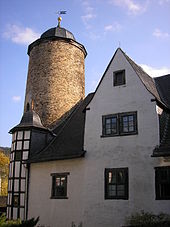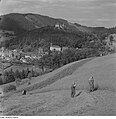People Mountain
| coat of arms | Germany map | |
|---|---|---|

|
Coordinates: 50 ° 34 ' N , 11 ° 27' E |
|
| Basic data | ||
| State : | Thuringia | |
| County : | Saalfeld-Rudolstadt | |
| Height : | 300 m above sea level NHN | |
| Area : | 57.52 km 2 | |
| Residents: | 2079 (Dec. 31, 2019) | |
| Population density : | 36 inhabitants per km 2 | |
| Postal code : | 07338 | |
| Area code : | 036734 | |
| License plate : | SLF, RU | |
| Community key : | 16 0 73 106 | |
| LOCODE : | DE LTB | |
| City structure: | 12 districts | |
City administration address : |
Markt 1 07338 Leutenberg |
|
| Website : | ||
| Mayor : | Robert Geheeb (Free Voters / SPD) | |
| Location of the town of Leutenberg in the Saalfeld-Rudolstadt district | ||
People mountain is a country town in the district of Saalfeld-Rudolstadt in Thuringia , called the "city of seven valleys".
geography
Menschenberg is located on the Sormitz , a tributary of the Loquitz , in the middle of the Thuringian Slate Mountains-Obere Saale nature park .
City structure
The city is divided into a total of nine districts:
|
In addition, there are the following locations in the area of today's city of Leutenberg that do not have the status of a district:
The seven valleys
- Hüttengrund (Kiesbachtal)
- Sormitztal
- Lemnitztal
- Ilm Valley
- Herschdorfer Valley
- Kalkgrubental
- Hinktal
history
The place was first mentioned in 1187 as Lutenberg . In 1208 the province of Saalfeld was given to Schwarzburg by King Otto IV . Peopleberg was presumably one of them, but without being explicitly mentioned.
The castle of the same name at the time is located high above the Sormitz valley northeast of the city center of Leutenberg. It was strategically built on a spur-like mountain head above the valley. It was built by the gentlemen von Leutenberg. They are officially named from 1187. In the 13th century the Counts of Schwarzburg are the owners, as the castle and land were handed over as imperial fiefs by King Otto IV .
In 1326, the city of Luthenberg is mentioned for the first time in a document . In 1395, the last Dominican monastery was built in the central German area in Leutenberg. From 1362 to 1564 the city and fortress was the seat of a separate line of the Schwarzburgers: Schwarzburg-Leutenberg . The Counts von Gleichen besieged the bastion in 1447 in vain. The end of the constant inheritance disputes between the Schwarzburgers and the Counts of Orlamünde was sealed in Leutenberg, since then the castle has been called " Friedensburg ". The name Friedensburg can be traced for the first time around 1564. It burned down in 1567 and again in 1934 and was always rebuilt. A specialist hospital for dermatology now resides in the well-preserved facility.
On October 8, 1564, with the death of Count Philipp I von Schwarzburg-Leutenberg, the line of the Schwarzburg-Leutenbergers went out and the city fell to Schwarzburg-Rudolstadt . It belonged to the sovereignty of this county until 1697 and from then until 1918 to the principality of the same name .
On May 7th, 1800 all of Leutenberg burned down, only seven buildings were spared from the fire.
During the Second World War there was a KLV camp in Leutenberg, which was used as part of the Kinderlandverschickung u. a. was inhabited by students from Düsseldorf. In addition, accommodation options were created in three Leutenberg inns: In the cookshop , in the Lower Friedensburg and in the Leutenberger Hof .
Since then, Leutenberg has been part of the Saalfeld district . Since the formation of the new district of Saalfeld-Rudolstadt on July 1, 1994 (initially under the name of Schwarza district ) Leutenberg has belonged to it.
Today's unified community "Stadt Leutenberg" was founded with the Thuringian law on the reorganization of district-related communities (Thuringian Community reshuffle law - ThürGNGG -) of December 23, 1996 (Section 22). And for this, the administrative community Obere Saale , consisting of the town of Leutenberg and the communities of Altenbeuthen, Dorfilm, Drognitz, Hirzbach, Landsendorf, Munschwitz, Neuenbeuthen, Reitzengeschwenda, Schweinbach and Steinsdorf, was dissolved. The new unified community was formed from the area of the dissolved town of Leutenberg and the dissolved communities of Dorfilm, Hirzbach, Landsendorf, Munschwitz, Schweinbach and Steinsdorf. Since then the city of Leutenberg has consisted of the nine districts Dorfilm, Herschdorf, Hirzbach, Kleingeschwenda, Landsendorf, Leutenberg, Munschwitz, Schweinbach and Steinsdorf.
politics
City council
After the city council election on May 26, 2019, the council of the city of Leutenberg consists of 14 council members:
| Party / list | Seats | +/- |
| CDU | 4th | - 1 |
| FDP | 3 | ± 0 |
| LINKE / Leutenberg social | 1 | ± 0 |
| FWG Leutenberg eV | 5 | + 1 |
| FFW Steinsdorf eV | 1 | ± 0 |
mayor
The political scientist Robert Geheeb (* 1977) has been Deputy Mayor since 2009, and has been Mayor of the city of Leutenberg since 2015.
coat of arms
Blazon : "In blue, a crowned golden lion with a red tongue and armor."
Town twinning
A partnership has existed with Stadtsteinach in Bavaria since 1990 and with the municipality of Hochspeyer in Rhineland-Palatinate since 1992 .
Culture and sights
The historic city center with half-timbered houses, fountains, church and town hall is well worth seeing. Information boards lead through the city and in the associated communities. A nature trail starts directly behind the church on the Schloßberg, on which native plants and animals around the mountain are explained. This also includes smaller peculiarities of the region, such as the mouflons imported from Corsica, the fire salamanders that also occur on the Schloßberg or lime-loving species such as pimpernut and liverwort.
At the end of the village in the direction of Wurzbach is the area of the nature park administration Thuringian Slate Mountains / Obere Saale with an extensive nature experience area along the Sormitz. In the administration building there is an exhibition about the nature park with mineral room.
The nature park administration trains certified nature guides who lead tourists and locals through the landscape in Leutenberg and in other areas of the nature park. The tours are spread over the entire nature park area from Saalfeld to Blankenstein and from the Plothener pond area to the Rennsteig.
Architectural monuments
From 1904 to 1945 there was a private pension at Schloss Friedensburg , to which several prisoners from the Hohenleuben women's prison were placed as employees during the National Socialist era, in order to evade them from being sent to a concentration camp.
Historical monuments
A Soviet grove of honor with the graves of 35 victims of forced labor , who were also reburied here from other places ( Kaulsdorf , Probstzella , Gräfenthal ), commemorates the forced labor of numerous workers from Eastern Europe, who also worked in the surrounding towns of Kleingeschwenda , Landsendorf , Gleima , Schweinbach and Hirzbach had to work. Since 1985 a stele at the intersection of Bahnhofstrasse and Saalfelder Strasse has been commemorating victims of the death marches in the district.
Personalities
- Friedrich Wilhelm Ludwig von Beulwitz (1755–1829), Chancellor of Schwarzburg-Rudolstadt and owner of the estates in Löhma, Munschwitz and St. Jakob
- Theodor Linschmann (1850–1940), clergyman and library director
- Hildegard Tauscher (1898–1971), rhythmist
Historical views
Web links
Individual evidence
- ^ Population of the municipalities from the Thuringian State Office for Statistics ( help on this ).
- ↑ Werner Mägdefrau : Thuringia in the late Middle Ages 1310–1482 / 85. On the life and work of German kings and Saxon-Thuringian landgraves from Friedrich the Freidigen to Sigmund to Wilhelm III, the brave (= Thuringia in the Middle Ages. Vol. 4). Rockstuhl, Bad Langensalza 2012, ISBN 978-3-86777-335-5 , p. 145.
- ↑ Michael Köhler: Thuringian castles and fortified prehistoric and early historical living spaces. Jenzig-Verlag Köhler, Jena 2001, ISBN 3-910141-43-9 , p. 104.
- ↑ Thomas Bienert: Medieval castles in Thuringia. 430 castles, castle ruins and fortifications. Wartberg-Verlag, Gudensberg-Gleichen 2000, ISBN 3-86134-631-1 , p. 236.
- ^ People Mountain Castle.
- ^ Chronicle of the city of Sonneberg 1757-1802 by Johann Martin Steiner . Stadtarchiv Sonneberg 2017, p. 451, ISBN 978-3-00-058293-6
- ↑ Max Liedtke (Ed.): Educated for Hitler? Letters and notes from Edgar Winzen from the Kinderlandverschickung Leutenberg / Thuringia in Thuringia 1944/45. Waxmann, Münster et al. 1999, ISBN 3-89325-765-9 , p. 18 ff.
- ↑ Law and Ordinance Gazette 2/20 December 30, 1996, pp. 333-340.
- ↑ bill state government printed matter 2/957 March 5, 1996.
- ^ StBA: Changes in the municipalities, see 1997
- ↑ https://wahlen.thueringen.de/datenbank/wahl1/wahl.asp?wahlart=GW&wjahr=2019&habenErg=GEM&wknr=073&gemnr=73106 Thuringian State Office for Statistics: Municipal council election 2019 in Thuringia - final result for Leutenberg
- ↑ http://www.leutenberg.de/politik/person/41782/b%C3%BCrgermeister-robert-geheeb
- ↑ Thuringian Association of the Persecuted of the Nazi Regime - Association of Antifascists and Study Group of German Resistance 1933–1945 (Ed.): Local history guide to sites of resistance and persecution 1933–1945. Volume 8: Thuringia. VAS - Verlag für Akademische Schriften, Frankfurt am Main 2003, ISBN 3-88864-343-0 , p. 237.


















